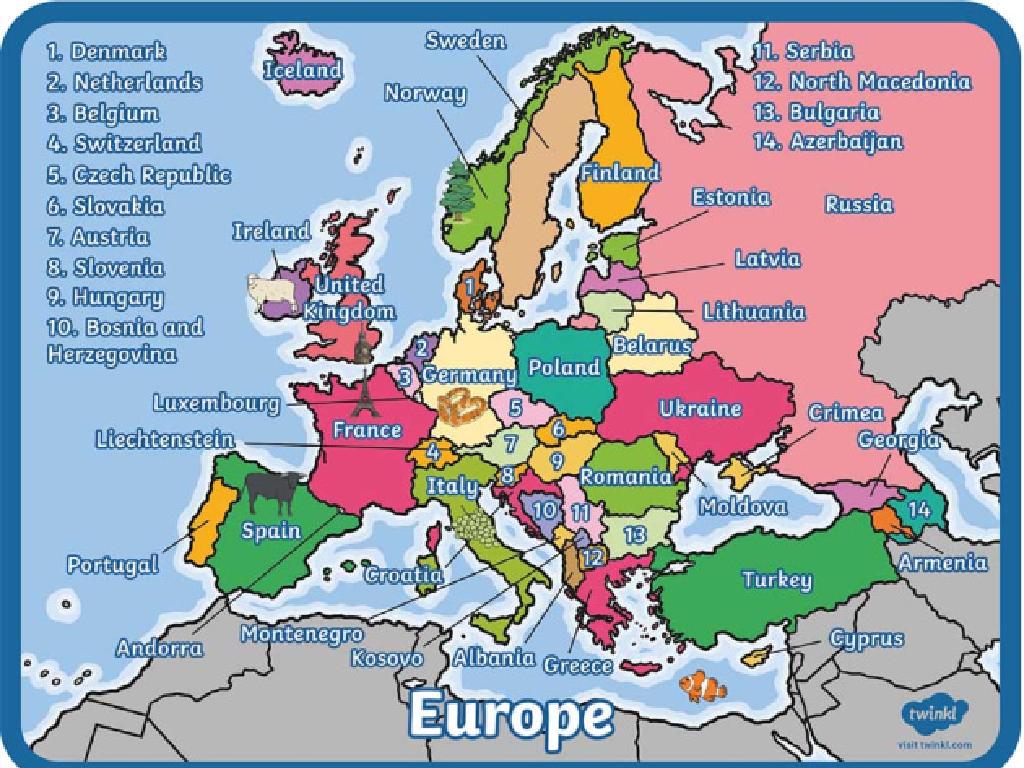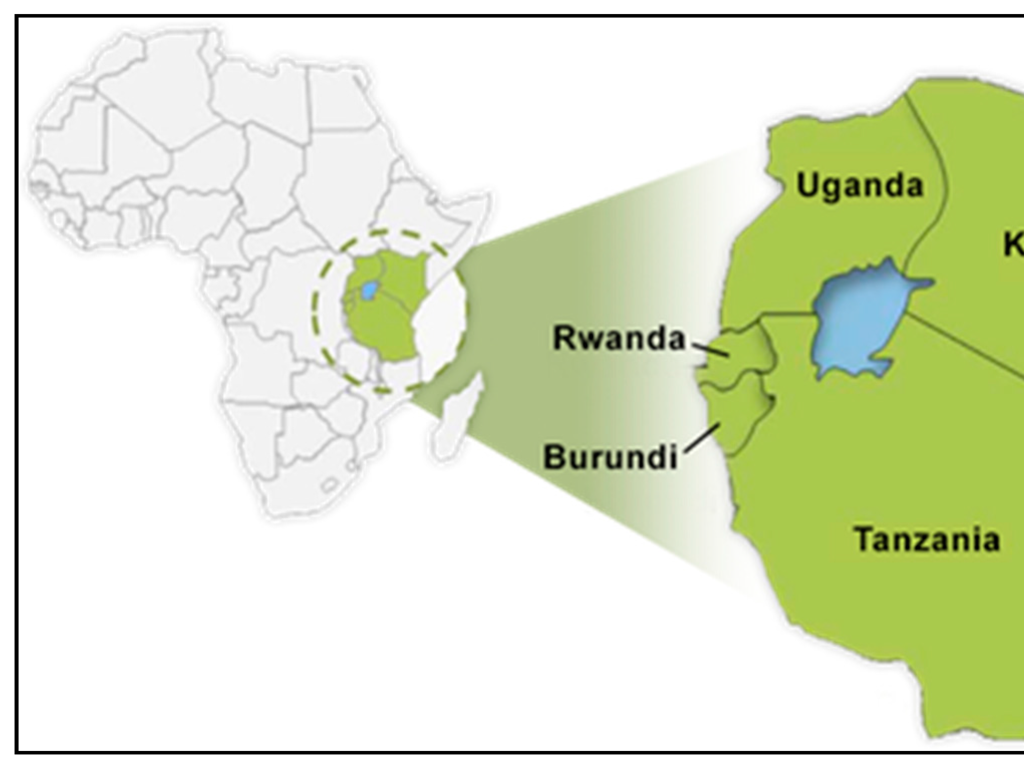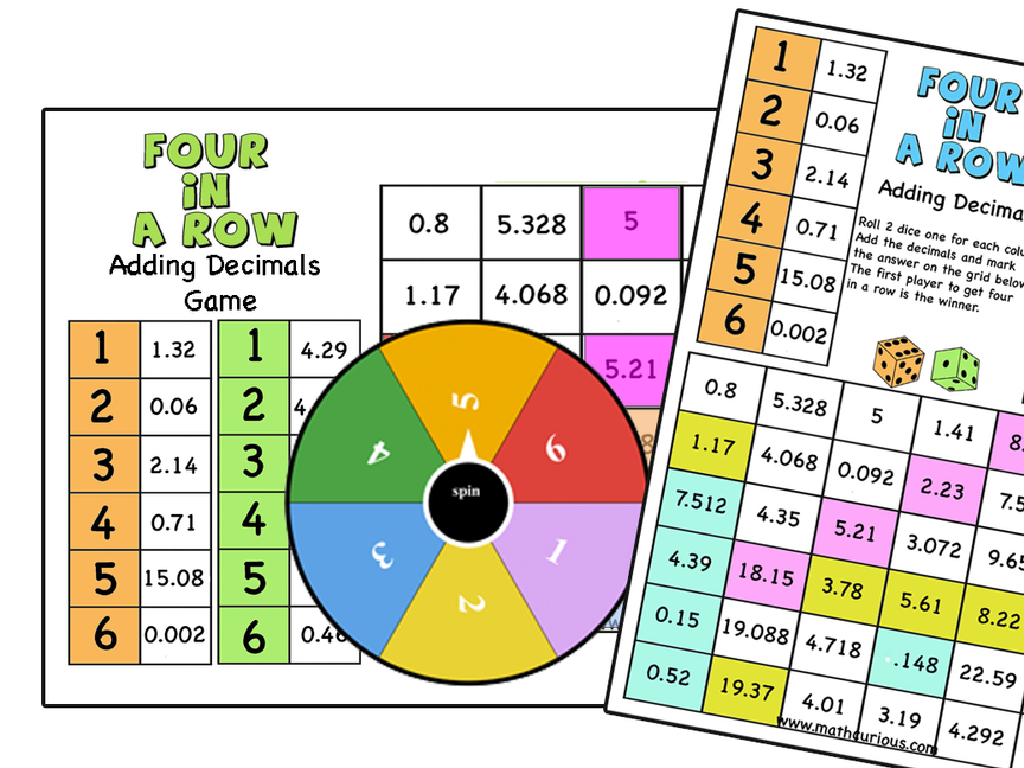Fractions With Denominators Of 10 And 100
Subject: Math
Grade: Fourth grade
Topic: Equivalent Fractions
Please LOG IN to download the presentation. Access is available to registered users only.
View More Content
Exploring Fractions: Denominators of 10 & 100
– Fractions represent parts of a whole
– Imagine a pizza cut into 10 or 100 slices
– Denominators 10 & 100 are special
– They make calculating and converting easier
– Real-life uses of these fractions
– Used in money, measurements, and more
– Mastering fractions is key in math
– Helps with advanced math concepts later
|
This slide introduces students to the concept of fractions, focusing on those with denominators of 10 and 100. Begin by explaining that fractions are a way to represent parts of a whole, like slices of a pizza. Emphasize that denominators of 10 and 100 are commonly used because they relate to our decimal system, making calculations and conversions simpler. Illustrate with examples such as money (dimes and pennies) and measurements (centimeters and meters). Stress the importance of understanding fractions as they form the foundation for more complex math topics in the future. Encourage students to think of other examples where they encounter fractions in their daily lives.
Understanding Fractions
– A fraction represents part of a whole
– Numerator and denominator explained
– Top number (numerator) and bottom number (denominator)
– Example: 1/10 as a fraction
– 1/10 means 1 out of 10 equal parts
– Visualizing fractions with denominators 10, 100
– Draw a circle divided into 10 or 100 parts
|
This slide introduces the concept of fractions to fourth-grade students. Begin by explaining that a fraction represents a part of a whole item or a group. Clarify the roles of the numerator and denominator, with the numerator indicating how many parts are being considered and the denominator showing the total number of equal parts that make up the whole. Use the example of 1/10 to illustrate a single part out of ten equal parts. To help students visualize, consider drawing a circle on the board and dividing it into 10 or 100 equal parts, showing how each part represents a fraction of the whole. Encourage students to think of other examples of fractions they encounter in daily life, such as cutting a pizza or sharing candy.
Fractions: Denominators of 10 and 100
– Understanding denominators
– Denominator: number of equal parts in a whole
– Special denominators: 10 and 100
– 10 and 100 make calculating easier
– Connection to the decimal system
– Our number system is based on 10s
– Practice with examples
– Convert 1/10 to 0.1 and 1/100 to 0.01
|
This slide introduces students to the concept of denominators, focusing on 10 and 100, which are particularly important because they relate directly to our base-10 decimal system. Understanding these denominators will help students convert fractions to decimals more easily. Emphasize that the denominator is like a slice of a pie, and when the pie is sliced into 10 or 100 pieces, it’s easier to see how it relates to whole numbers. Provide examples such as converting 1/10 to 0.1 and 1/100 to 0.01 to illustrate the concept. Encourage students to find fractions around them, like a dime being 1/10 of a dollar, to make learning more tangible.
Understanding Equivalent Fractions
– Equivalent fractions have the same value
– Example: 1/10 is the same as 10/100
– Both fractions equal 0.1 or 10%
– Methods to find equivalent fractions
– Multiply or divide numerator and denominator by the same number
– Practice with different denominators
– Use 10 and 100 to see patterns in equivalence
|
This slide introduces the concept of equivalent fractions, which are different fractions that represent the same value. Start by explaining that even though the numbers look different, the fractions can be equal, like 1/10 and 10/100. Show how to find equivalent fractions by multiplying or dividing both the numerator and denominator by the same number. Emphasize that this does not change the value of the fraction. Provide examples using denominators of 10 and 100 to illustrate the concept clearly. Encourage students to practice finding equivalent fractions with these denominators to reinforce their understanding. The goal is for students to recognize patterns and become comfortable with the concept of equivalence in fractions.
Creating Equivalent Fractions
– Multiply or divide both parts of a fraction
– Example: 1/10 becomes 10/100
– By multiplying numerator & denominator by 10
– Convert 3/10 to a denominator of 100
– Multiply 3/10 by 10 to get 30/100
– Practice with different fractions
– Try converting 2/10 and 5/10 as well
|
This slide introduces the concept of creating equivalent fractions by multiplying or dividing both the numerator and denominator by the same number. Start by explaining that this process does not change the value of the fraction, just its appearance. Use the example of multiplying 1/10 by 10 to get 10/100 to illustrate this concept. Then, guide the students through converting 3/10 into a fraction with a denominator of 100 by multiplying both the numerator and denominator by 10 to get 30/100. Encourage students to practice this skill with different fractions, such as 2/10 and 5/10, to reinforce their understanding. The goal is for students to become comfortable with the idea of equivalent fractions and understand how to create them.
Using Models to Understand Fractions
– Visual models show equivalent fractions
– A picture or diagram can represent parts of a whole
– Draw a model for 1/10 and 10/100
– Use grids or bars to represent 1/10 and 10/100
– Observe equal space taken by fractions
– Both fractions fill the same area, showing they are equivalent
|
This slide aims to help students visualize the concept of equivalent fractions using models. By drawing models such as fraction bars or grids, students can see that 1/10 and 10/100 cover the same amount of space, which helps them understand that these two fractions are equivalent. It’s crucial to emphasize that although the numbers look different, the represented value is the same. Encourage students to draw their own models and to use this method to find other equivalent fractions. This visual approach is particularly effective for fourth graders as it provides a concrete way to grasp abstract mathematical concepts.
Practice Time: Converting Fractions
– Convert 2/10 to a denominator of 100
– Multiply both numerator and denominator by 10 to get 20/100
– What is 40/100 with a denominator of 10?
– Divide both numerator and denominator by 10 to get 4/10
– Understand the usefulness of conversion
– Converting fractions helps compare and add different fractions
– Class activity: Practice conversions
|
This slide is designed for a class activity where students practice converting fractions with denominators of 10 to 100 and vice versa. Start by guiding students through the process of multiplying or dividing both the numerator and denominator to convert fractions. Explain that this skill is important for comparing fractions, adding and subtracting fractions with different denominators, and understanding decimal equivalents. For the activity, provide additional fractions for students to convert, and encourage them to explain their reasoning. Possible activities include peer teaching, using visual fraction models, and creating real-life scenarios where fraction conversion is used.
Class Activity: Fraction Scavenger Hunt
– Find divisible classroom items
– Create fractions with 10 and 100
– For example, if 2 out of 10 seats are blue, the fraction is 2/10
– Share and explain equivalents
– Explain how 2/10 is equal to 20/100 using multiplication
– Understand real-world fractions
|
This activity is designed to help students apply their knowledge of fractions with denominators of 10 and 100 to real-world objects. Students will search the classroom for items that can be divided into parts, such as a set of markers or a bookshelf with a certain number of books. They will then create fractions representing parts of the whole for those items. Afterward, students will share their fractions with the class and explain why they are equivalent, reinforcing the concept of equivalent fractions. For example, if a student finds 2 out of 10 seats are blue, they would write the fraction as 2/10 and then convert it to 20/100 to show equivalence. Teachers should circulate to provide guidance and ensure students understand how to scale up fractions to find equivalents. Possible activities include finding different colored objects, counting items like books or tiles, or even using features of the classroom like windows or desks.
Conclusion & Reflection: Fractions in Our Lives
– Recap on today’s fractions lesson
– We learned about fractions with denominators of 10 and 100 and how to find equivalent fractions.
– Real-life application of fractions
– Fractions are everywhere! From cooking to sharing pizza, they help us divide and share things equally.
– Homework: Fraction hunt at home
– Find items like a pizza or a jug of milk and write their fractions.
– Share your findings next class
|
Today, we’ve explored fractions with denominators of 10 and 100, focusing on understanding and creating equivalent fractions. It’s crucial for students to see the practical side of fractions in everyday life, such as in measuring ingredients or dividing goods. For homework, students are tasked to find three items at home and write down their fractions, which reinforces the day’s lesson and builds real-world connections. In the next class, students will have the opportunity to discuss their findings, allowing them to learn from each other and see the variety of fractions around them.





